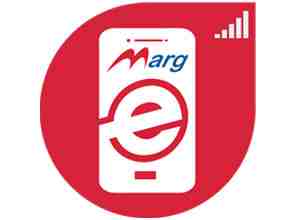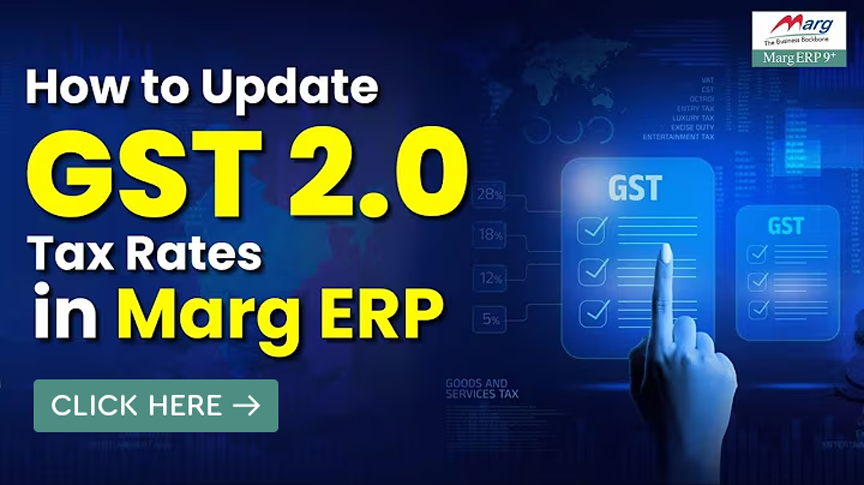Search by Category
- Marg Nano
- Swiggy & Zomato
- ABHA - Ayushman Bharat
- Marg Cloud
-
Masters
- Ledger Master
- Account Groups
- Inventory Master
- Rate and Discount Master
- Refresh Balances
- Cost Centre Master
- Opening Balances
- Master Statistics
- General Reminder
- Shortage Report
- Supplier Vs Company
- Temporary Limit
- Shop QRID and eBusiness
- Cloud Backup Setup
- Password and Powers
- Marg Licensing
- Marg Setup
- Target
- Budget
- Credit Limit Management
- Change ERP Edition
- Ease Of Gst Adoption
-
Transactions
- ERP To ERP Order
- Sale
- Purchase
- Sale Return
- Purchase Return
- Brk / Exp Receive
- Scrap Receive
- Brk / Exp Issue
- Scrap Issue
- GST Inward
- GST Outward
- Replacement Issue
- Replacement Receive
- Stock Issue
- Stock Receive
- Price Diff. Sale
- Price Diff. Purchase
- BOM
- Conversion
- Quotation
- Sale Order
- Purchase Order
- Dispatch Management
- ERP Bridger
- Transaction Import
- Download From Server
- Approvals
- Pendings
- Accounts
- Online Banking
-
Books
- Cash and Bank Book
- All Ledgers
- Entry Books
- Debtors Ledgers
- Creditors Ledger
- Purchase Register
- Sale Register
- Duties & Taxes
- Analytical Summaries
- Outstandings
- Collection Reports
- Depreciation
- T-Format Printing
- Multi Printing
- Bank Reconcilation
- Cheque Management
- Claims & Incentives
- Target Analysis
- Cost Centres
- Interest and Collection
- Final Reports
-
Stocks
- Current Stock
- Stock Analysis
- Filtered Stock
- Batch Stock
- Dump Stock
- Hold/Ban Stock
- Stock Valuation
- Minimum Level Stock
- Maximum Level Stock
- Expiry Stock
- Near Expiry Stock
- Stock Life Statement
- Batch Purchase Type
- Departments Reports
- Merge Report
- Stock Ageing Analysis
- Fast and Slow Moving Items
- Crate Reports
- Size Stock
-
Daily Reports
- Daily Working
- Fast SMS/E-Mail Reports
- Stock and Sale Analysis
- Order Calling
- Business on Google Map
- Sale Report
- Purchase Report
- Inventory Reports
- ABC Analysis
- All Accounting Reports
- Purchase Planning
- Dispatch Management Reports
- SQL Query Executor
- Transaction Analysis
- Claim Statement
- Upbhogkta Report
- Mandi Report
- Audit Trail
- Re-Order Management
- Reports
-
Reports Utilities
- Delete Special Deals
- Multi Deletion
- Multi Editing
- Merge Inventory Master
- Merge Accounts Master
- Edit Stock Balance
- Edit Outstanding
- Re-Posting
- Copy
- Batch Updation
- Structure/Junk Verificarion
- Data Import/Export
- Create History
- Voucher Numbering
- Group of Accounts
- Carry Balances
- Misc. Utilities
- Advance Utilities
- Shortcut Keys
- Exit
- Generals
- Backup
- Self Format
- GST Return
- Jewellery
- eBusiness
- Control Room
- Advance Features
- Registration
- Add On Features
- Queries
- Printing
- Networking
- Operators
- Garment
- Hot Keys
-
GST
- E-Invoicing
- Internal Audit
- Search GSTIN/PARTY
- Export Invoice Print
- Tax Clubbing
- Misc. GST Reports
- GST Self-Designed Reports
- GST Return Video
- GSTR Settings
- Auditors Details
- Update GST Patch
- Misc. GST Returns
- GST Register & Return
- GST RCM Statement
- GST Advance Statement
- GST Payment Statement
- Tax Registers and Summaries
- TDS/TCS Reports
- Form Iss./Receivable
- Mandi
- My QR Code
- E-Way Bill
- Marg pay
- Saloon Setup
- Restaurant
- Pharmanxt free Drugs
- Manufacturing
- Password and Power
- Digital Entry
Home > Margerp > Inventory Master > How to create New item in Marg ERP Software ?
How to create New item in Marg ERP Software ?
Item Master in Marg ERP Software is used for the creation of an item. It is necessary to create items to maintain the stock in the software.
- Go to Masters > Master > Item Master.
- The user will press 'F2' key on it to create new item.
- The user will feed all the necessary details as per the requirement.
a. Status: If an item is continued for billing then select ‘Continue’ otherwise select ‘Close’.
Suppose selects ‘Continue’.
b. Type: If an item is being used for billing then select ‘Normal’, otherwise select ‘Prohibited’. Suppose, select ‘Normal’.
c. Hide: If there is need to hide this item then select ‘Yes’, otherwise select ‘No’. Suppose, select ‘No’.
d. Code: Enter the item code beside the code option.
e. Rack No.: The user will enter the Rack Number as per the requirement.
f. Product: The user will mention the name of the item as per the requirement. Suppose enter ‘Amifru 40’.
g. Print Name: The user will mention the Print Name of the item as per the requirement.
h. Packing: The user will mention the Packing of Item as per the requirement.
i. Unit: Enter the unit name beside the unit option. Suppose, mention ‘PCS’.
j. Decimal: If loose qty needs to be sold then select ‘Yes’ otherwise keep it as ‘No’.
Suppose, select ‘No’.
k. Fast Search: Enter the code by which user can search this item at the time of billing.
l. Color Type: Select the desired color for item classification. Suppose, selects ‘Normal’.
m. Item Type: Select the desired type for item.
Suppose, select ‘Normal’.
n. Company: The user can select the company of the product by select ‘No’ from the drop down.
The user will select the company and press 'Enter' key on it. Suppose, select ‘Glaxo India limited’.
o. Salt: The user will select the salt of the product by select ‘No’ from the drop down.
- The user will select salt and press 'Enter' key on it. Suppose, selects ‘Crocin’.
p. HSN/SAC: The user can select the HSN of the product by select ‘No’ from the drop down.
The user will select HSN and press 'Enter' key on it. Suppose, selects ‘98765424’.
q. Local: Select whether the item is taxable, tax paid or exempted.
- Taxable- Taxable option is used when tax is to be applied on any saleable good. Suppose, the item of Rs.100 and user has to give 5% tax on it. So when this item is sold, the amount will be Rs. 105 i.e. Rs. 100 bill amount + Rs. 5 tax. So, tax % is excluded in sale bill.
- Tax Paid- Tax% is included in Tax Paid. Suppose, bill is of Rs 100 and 5% tax is included in the bill i.e. Rs 95 is the value of goods of 5% tax and Rs. 100 is the total bill amount.
- Exempted- Exempted means tax free, which means customer doesn’t have to pay tax in this.
- Suppose select ‘Taxable’.
r. Central: If the item is on sale from one state to another state then select ‘Taxable’ otherwise select ‘Exempted’.
Suppose, select ‘Taxable’.
s. Cost/PCS: Cost will be automatically generated when the purchase is generated.
t. Conversion Box: Enter conversion of the Item like ml, kg, gms, pcs, pkt etc.
- Suppose, in pharma trade a box has '10' strips so enter '10'.
u. Conv. Case: Enter the number of strips in one box.
- Suppose, there are 10 tablets in 1 strip, so enter 10.
v. Minimum Qty: The user will enter the minimum quantity that should be available of an item.
Suppose enter '10'.
w. Maximum Qty: The user will enter the maximum quantity that should be available of an item.
x. Reorder Qty: Enter the quantity which the user wants to reorder after generation of order of any item when its quantity is low.
Suppose mention '10'.
y. Volume Discount: Enter the percentage discount to add for this item.
z. Item Discount: Enter the percent discount for this item.
Suppose enter '2'.
aa. Special Disc: Special discount is given when any party purchases goods in bulk.
To give special discount of 5% to any party on the purchase of 1000 qty, set 5% in special discount and enter '1000' in ‘On Quantity’.
ab. Maximum Discount %:Enter the maximum discount % to give on this item.
ac. Purchase Discount: Define the percentage discount the user will get on the purchase of this item.
ad. F6 Rate plus minus Effect: This option is used when the user wants to sale this item on discount or wants to charge extra amount on its sale actual rate to a party.
Suppose select ‘Yes’.
ae. Free Scheme: Schemes are of 2 types i.e. Batch Wise and Master Wise.
Here 'M' means ‘Master wise’ so the software is asking for free scheme & this option would not have appeared in case of batch wise.
Suppose enter '10 + 1' i.e. on the purchase of 10 quantities, 1 quantity will be free.
af. Valid From: In this there are 7 options as follows:
- Full Scheme- Suppose, 1 strip is free with 10 quantities, then nothing will be free with 5 quantities as it is less than 10 quantities. Similarly, 1 packet will be free with 15 quantities and 2 packets with 20 quantities. Here, free quantity will be 1, 2, 3 i.e. whole numbers.
- Half Scheme- If 1 quantity is free with 10 quantities then 0.45 quantity will be free with 5 quantities i.e. software will set free quantity for less than 10 quantities as well. Similarly, software will apply free scheme of 0.82 quantity with 9 quantities.
- 1/3 Scheme- Suppose, a party has purchased 3 strips of crocin pain relief, then also free scheme will be applied.
- Qtr. Scheme- Suppose, the user has sold 2.5 quantities to the party, then also free scheme will be applicable.
- All Scheme- Suppose, the user is billing for just 1 strip to party then also free scheme will be applicable.
- Whole Scheme- Whole scheme means scheme will be cut on Odd Quantity as well.
- No Scheme- No Scheme means the user doesn’t want to give any scheme to the party.
- Suppose select ‘Full Scheme’.
Enter the date that till when you want to keep this full scheme valid.
ag. Minimum Margin: Enter how much margin the user wants from this product.
Suppose enter '5%'.
ah. Discount Less: The user will enter the discount percentage to less on this item.
ai. Manufacture F3 List: The user will enter the name of the manufacturer which has manufactured this item.
aj. Narcotic: The user will set ‘Yes’ if this item is intoxicated else set ‘No’.
Suppose select ‘No’.
ak. Schedule H: If there is less quantity of narco in this item, then set ‘Yes’ and if there is no quantity of narco in this item then set ‘No’.
Suppose select ‘No’.
al. Schedule H1:If this item comes under Schedule H1 then select ‘Yes’ otherwise keep it as ‘No’.
Suppose select ‘Yes’.
- Press 'Ctrl+W' key to save the changes.
- The user will click on 'Yes' button to save the details.
After following the above steps, the user can Create New Item in Marg ERP Software.


 -
Marg ERP 9+
-
Marg ERP 9+











